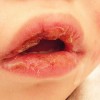Pyrogenic reactions in patients undergoing cardiac catheterization associated with contaminated glass medicine cups
Abstract
Pyrogenic reactions are potentially life-threatening complications caused by bacterial endotoxin. After two cardiac catheterization patients developed rigors the same day, the procedures were halted and a case control study was conducted. To identify case patients (persons with rigors < or = 3 hr after catheterization during September 25-November 9, 1995), we reviewed medical records of all cardiac catheterization patients who had a blood culture or received intravenous meperidine. Twelve case patients and 40 randomly selected control patients were identified. No specific catheter was associated with case patients, but exposure to intracoronary-nitroglycerin (NTG) was (odds ratio = 12.0; 95% confidence interval 2.2, 75.6). NTG or indocyanine green dye was poured into glass medicine cups previously washed in an enzyme cleaner and then sterilized. The cleaner, used for an entire day, had elevated levels of gram-negative bacteria (> 10(4) colony forming units/mL) and endotoxin (434 endotoxin units [EU]/mL]); the reprocessed cups had no live bacteria but had elevated endotoxin levels (median 2,250 EU).… Read more
